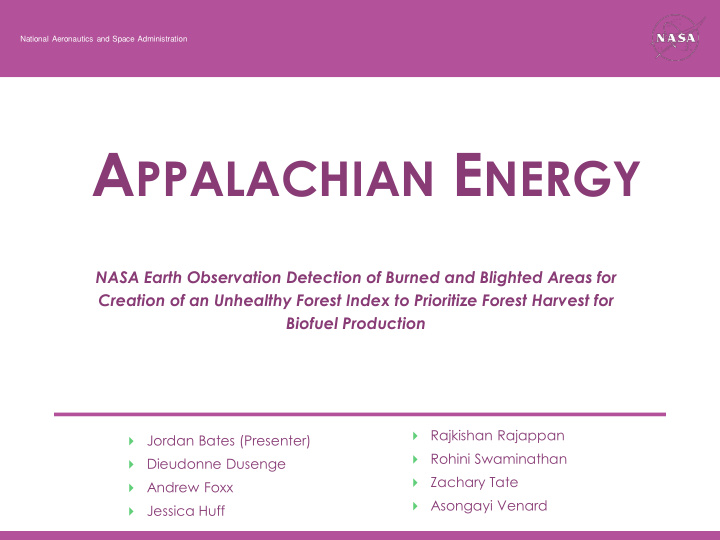



National Aeronautics and Space Administration A PPALACHIAN E NERGY NASA Earth Observation Detection of Burned and Blighted Areas for Creation of an Unhealthy Forest Index to Prioritize Forest Harvest for Biofuel Production Rajkishan Rajappan Jordan Bates (Presenter) Rohini Swaminathan Dieudonne Dusenge Zachary Tate Andrew Foxx Asongayi Venard Jessica Huff
Community Concerns Forests are under pressure from human activities such as residential development, agriculture and logging Natural factors: fires and invasions of pests such as the gypsy moth and the Hemlock woolly adelgid Biomass energy production destroys a large amount of healthy trees
Study Area Central Appalachian Mountains in the states of: North Carolina Virginia West Virginia Kentucky Tennessee
Objectives and Partners Objective: Utilize NASA Earth observations to detect recently burned and blighted forests Results will help prioritize harvest of timber stocks on public lands to decrease fuel load and fire risk and create biofuels to meet energy needs Partners: U.S. Forest Service Virginia Department of Agriculture and Forestry EnviraCarbon Inc. (boundary organization) Wise County, through EnviraCarbon, Inc.
Methodology Products Data processing 1. Arc GIS 2. MODIS Data collection Reprojection Tool (MRT) Landsat 5 3. Python Terra Aqua Landsat 8
Project Flowchart Data Collection Data Processing Aqua/Terra MODIS Normalized Difference Results Vegetation Index Landsat 5 (NDVI) Thematic Mapper Landsat 8 Dead Forest Normalized Operational Land Extent Difference Imager Vegetation Index (NDWI) US Forest Service Data Normalized Burn Ration (NBR) FORWARN
Forest Type Hardwoods can resist defoliation and withstand decomposition longer than softwoods Softwoods die and decompose more easily Data obtained from US Forest Service
Forest Fires 𝐶𝑏𝑜𝑒 4 −𝐶𝑏𝑜𝑒 6 𝐶𝑏𝑜𝑒 4+𝐶𝑏𝑜𝑒 6 𝑂𝐶𝑆 = (in Landsat 8) Comparatively small scale fires happen in the Appalachian region Not profitable for timber harvest
Hemlock Wooly Adelgid Infestation Hemlocks are evergreen and recently affected by exotic insect, the wooly adelgid Hemlock infested areas have negative values due to defoliation
Wooly Adelgid Infestation Animation
Gypsy Moth Infestation Gypsy moth infested areas show negative difference due to defoliation Results collected from FORWARN
Gypsy Moth Detection The gypsy moth causes defoliation NDWI images can be used for change detection
Following Term of Work In the following term, we extended the study area to the State of Texas The new project was called South East United States Energy We used the same methodology but added droughts as a factor to consider when identifying unhealthy forests
South East Unites States Energy II NDVI with areas affected by SDCI = (0.25) Vegitation (NDVIs) invasive species marked + (0.25) Temperature LSTs + (0.5) Precipitation (Ps) 4,300 acres of forests in Virginia, 6,000 acres in Mississippi and 3,700 acres in Louisiana were identified SDCI model takes into account as infected with insects temperature, rainfall and vegetation indices to compute an estimation of drought severity
Conclusion Results from this project can help the partners to identify unhealthy forests or dead wood for harvest and reforestation Identifying dead forests will substantially decrease the deforestation of healthy forests and also increase fuel production efficiency Acknowledgement Dr. Kenton Ross NASA DEVELOP Science Advisor Dr. Steve Hooper CEO, EnviraCarbon, Inc
Recommend
More recommend